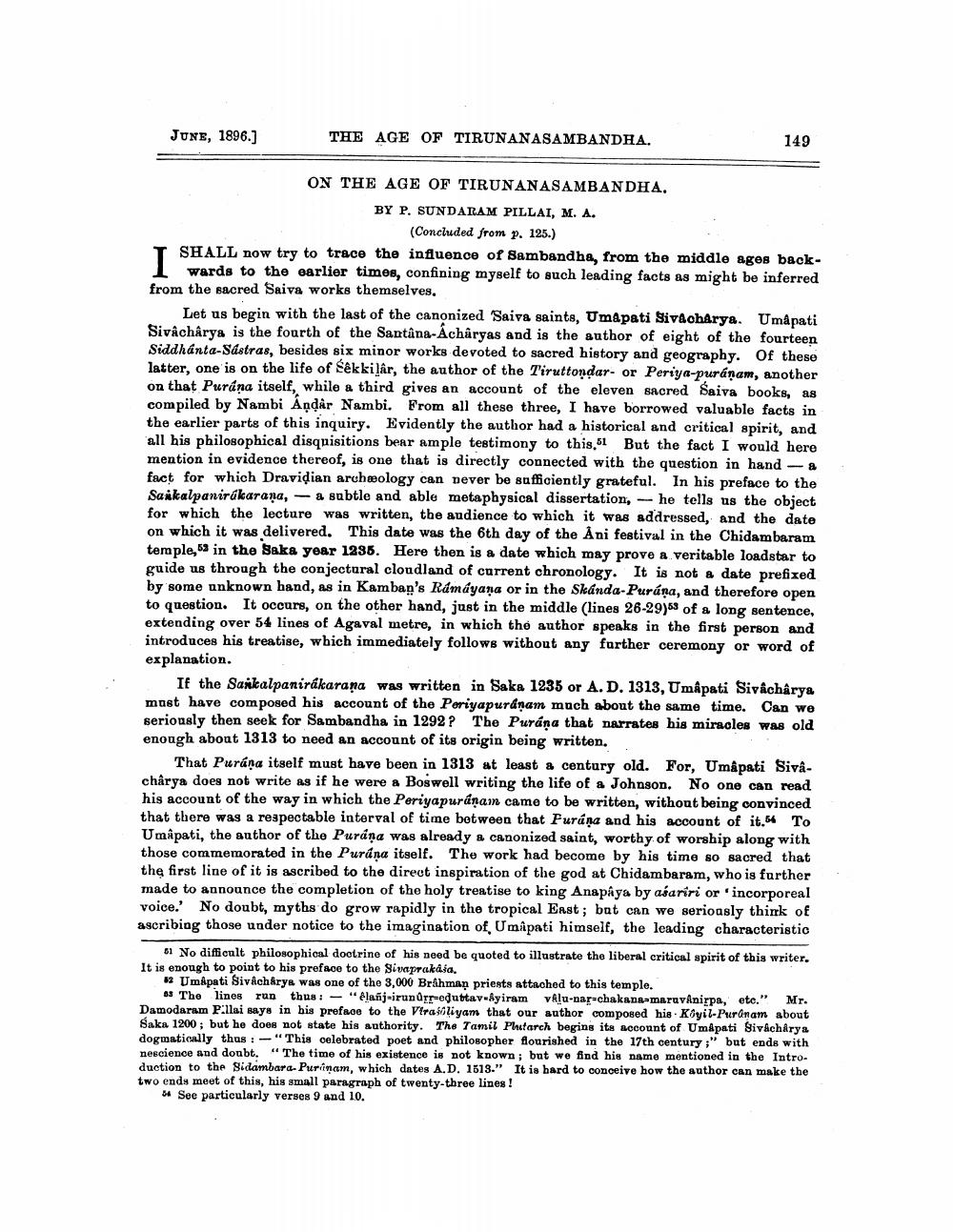________________
JUNE, 1896.)
THE AGE OF TIRUNANASAMBANDHA.
149
ON THE AGE OF TIRUNANASAMBANDHA.
BY P. SUNDARAM PILLAI, M. A.
(Concluded from p. 125.) T SHALL now try to trace the influence of Sambandha, from the middle ages back1 wards to the earlier times, confining myself to such leading facts as might be inferred from the sacred Saiva works themselves,
Let us begin with the last of the canonized Saiva saints, Umapati Sivacharya. Umâpati Sivâchârya is the fourth of the Santâna-Acharyas and is the author of eight of the fourteen Siddhanta-Sastras, besides six minor works devoted to sacred history and geography. Of these latter, one is on the life of Sêkkilar, the author of the Tiruttondar- or Periya-puranam, another on that Purana itself, while a third gives an account of the eleven sacred Saiva books, as compiled by Nambi Andar Nambi. From all these three, I have borrowed valuable facts in the earlier parts of this inquiry. Evidently the author had a historical and critical spirit, and all his philosophical disqnisitions bear ample testimony to this.51 But the fact I would here mention in evidence thereof, is one that is directly connected with the question in hand- & fact for which Dravidian archæology can never be sufficiently grateful. In his preface to the Sankalpanirúkarana, - & subtle and able metaphysical dissertation, he tells us the object for which the lecture was written, the audience to which it was addressed, and the date on which it was delivered. This date was the 6th day of the Ani festival in the Chidambaram temple, 52 in the Baka year 1236. Here then is a date which may prove a veritable loadstar to guide us through the conjectural cloudland of current chronology. It is not a date prefixed by some unknown hand, as in Kambap's Ramayana or in the Skanda-Purána, and therefore open to question. It occurs, on the other hand, just in the middle (lines 26-29968 of a long sentence, extending over 54 lines of Agaval metre, in which the author speaks in the first person and introduces his treatise, which immediately follows without any further ceremony or word of explanation.
If the Sankalpanirákarana was written in Saka 1235 or A.D. 1313, Umâpati Sivacharya mast have composed his account of the Periyapuranam much about the same time. Can we seriously then seek for Sambandha in 1292 ? The Puráņa that narrates his miracles was old enough about 1313 to need an account of its origin being written,
That Purána itself must have been in 1313 at least a century old. For, Umapati Sivacharya does not write as if he were a Boswell writing the life of a Johnson. No one can read his account of the way in which the Periyapuranam came to be written, without being convinced that there was a respectable interval of time between that Furána and his account of it. To Umapati, the author of the Purána was already a canonized saint, worthy of worship along with those commemorated in the Purana itself. The work had become by his time so sacred that the first line of it is ascribed to the direct inspiration of the god at Chidambaram, who is further made to announce the completion of the holy treatise to king Anapaya by asariri or 'incorporeal voice. No doubt, myths do grow rapidly in the tropical East; bat can we seriously think of ascribing those under notice to the imagination of Umapati himself, the leading characteristic
61 No difficult philosophical doctrine of his need be quoted to illustrate the liberal critical spirit of this writer. It is enough to point to his preface to the Sivaprakdía.
3 Umapati Sivåch krye was one of the 3,000 Brahman priests attached to this temple.
63 The lines run thus: - "elañj-irun orr-eduttav-Syiram vAlu-nar-chakana maravênirpa, etc." Mr. Damodaram Pillai says in his preface to the Virašiliyam that our author composed his. Koyil-Purinam about Saka 1200 ; but he does not state his authority. The Tamil Plutarch begins its account of Umapati Sivacharya dogmatically thus: -"This celebrated poet and philosopher flourished in the 17th century;" but ends with nescience and doubt. "The time of his existence is not known : but we find his name mentioned in the Intro. duction to the Sidambara-Purinam, which dates A.D. 1513." It is hard to conceive how the author can make the two ends meet of this, his small paragraph of twenty-three lines!
* See particularly verses 9 and 10.




